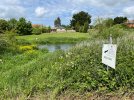It was, if I recall, actually at the request of the locals, because they didn't want to become an unofficial A34 Parkway (the station is very, very convenient, being just off that road). The infrequent service suits their purpose (if any ever bother using it) and they can drive to Oxford Parkway (it's one of those expensive, posh villages with basically 100% car ownership) if they want more frequency.
(Curious thing: Oxford Parkway is literally right next to the A34 but reaching it from the road is a massive faff via Kidlington - I wonder if they ever intended to add another junction?)
I very strongly suspect 100% of households in Islip have at least one car, most probably two or more, and kids would be able to use their bicycle (Oxford is big on cycling) to reach Parkway easily enough if they wanted (but equally kids mostly seem happy to arrange their lives around infrequent train services in rural areas if not getting a lift in Daddy's Range Rover/Jag). It's that sort of place. You don't move to little villages without being a driver.
To go into Oxford they probably drive to Pear Tree P&R for the frequent service from there.
Have a look at a map. It's quicker to get to from the A34 than Oxford Parkway is, and their village would have become littered with cars parking for free rather than paying at Parkway. Asking for a less frequent service removed that appeal.
(I don't entirely see, pre Parkway, any point in the Water Eaton P&R site, the shortest route to it by road involves passing within about 100m of the Pear Tree site - unless it was just overflow or perhaps avoiding peak congestion at the Pear Tree roundabout by reaching it via Kidlington as I think the signage suggests)
What a lot of nonsense. No one asked for fewer trains to call - Chiltern decided that was what was going to happen.
People in Islip were pretty angry when Chiltern unveiled its planned timetables for the reopening of the line after the redoubling work and construction of the link line at Bicester. The plans cut the number of trains into and out of central Oxford to eight each way, down from the 11 trains each way provided by FGW from 2009 to 2014 with county council support. This change saw custom at Islip double between 2008 and 2012 (up from 14,000 to 28,000 entries and exits per year), as the train was a reliable and convenient way to get in and out of Oxford all day, once the previous gaps in the timetable had been plugged.
Exactly the same reason why so many people from well-heeled parts of West Oxfordshire use Cotswold Line trains between Charlbury, Hanborough and Oxford. It doesn't matter how posh people may be or how many cars they own when you know that venturing to Oxford in a car means you will get stuck in congestion much of the time - even when trying to get to the Pear Tree park-and ride site, as the A34/A40/A44/A4260 junctions area north of the city can get nicely clogged up at peak times.
Water Eaton park and ride was built in part because Pear Tree was operating near to full capacity most of the time, with people struggling to find parking spaces. This has never been the case at Water Eaton, which provides a handy alternative option to park and ride just up the road.
And some people in Islip do bother using the train, with 20,454 entries and exits recorded there in 2021-22 - while the number of trains calling now is back up to the level of the 2009-2014 enhanced timetable.
Looking at the sort of village it is, that's a handful of people.
It's like Shipton under Wychwood tbh.
If Shipton station had a better service, more people would use it. As the service is so poor, people living in Shipton-under-Wychwood and Milton-under-Wychwood (combined population about 3,700), drive to Charlbury or Kingham instead. Honeybourne, further up the Cotswold Line, has several hundred fewer residents but a lot more trains calling, so people there use their local station.

